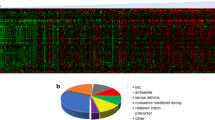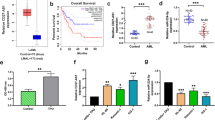Abstract
Acute myeloid leukemia (AML) is a form of blood cancer that arise as a result of clonal proliferation of malignant myeloid precursors acquiring genetic abnormalities. Primary resistance to initial treatment and disease recurrence continues to be huge challenge in treating AML. Herein, GSE114868 was analyzed for differentially-expressed lncRNAs between AML patients’ mononucleated cells and healthy normal control mononucleated cells and 191 lncRNAs were significantly deregulated in AML patients’ mononucleated cells. The correlation between candidate lncRNAs and AML patients’ overall survival was analyzed and 6 lncRNAs, including MIR181A1HG, TRAF3IP2-AS1, STARD4-AS1, E2F3-IT1, FAM215A, and HHIP-AS1 were dramatically linked to AML patients’ OS. Using a Cox proportional-hazards model, we identified risk factors and found FAM215A as a risk factor for AML patients’ prognosis. The expression level of FAM215A showed to be upregulated within blood samples and cells. Genes correlated with FAM215A were correlated to cell division, modulation of cell apoptosis, and modulation of programmed cell death. FAM215A knockdown inhibited AML cell viability, elicited G0/G1-phase arrest of cell cycle, enhanced cell apoptosis, increased proapoptotic Bax and cleaved-caspase3 levels, and decreased antiapoptotic Bcl2. FAM215A overexpression exerted opposite effects on AML cells. Conclusively, FAM215A serves as an oncogenic lncRNA in AML, promoting cell viability, relieving cell cycle arrest, and suppressing cell apoptosis. FAM215A might be un underlying biological prognostic marker and therapeutic target for AML.




Similar content being viewed by others
Data availability
Please contact the authors for data requests.
References
Arber DA et al (2016) The 2016 revision to the World Health Organization classification of myeloid neoplasms and acute leukemia. Blood 127(20):2391–2405
Bolouri H et al (2018) The molecular landscape of pediatric acute myeloid leukemia reveals recurrent structural alterations and age-specific mutational interactions. Nat Med 24(1):103–112
De Kouchkovsky I, Abdul-Hay M (2016) Acute myeloid leukemia: a comprehensive review and 2016 update. Blood Cancer J 6(7):e441
Dohner H, Weisdorf DJ, Bloomfield CD (2015) Acute Myeloid Leukemia N Engl J Med 373(12):1136–1152
Elmore S (2007) Apoptosis: a review of programmed cell death. Toxicol Pathol 35(4):495–516
Fernando TR et al (2017) The lncRNA CASC15 regulates SOX4 expression in RUNX1-rearranged acute leukemia. Mol Cancer 16(1):126
Fu Y et al (2016) Long non-coding RNAs, ASAP1-IT1, FAM215A, and LINC00472, in epithelial ovarian cancer. Gynecol Oncol 143(3):642–649
Grimwade D, Ivey A, Huntly BJ (2016) Molecular landscape of acute myeloid leukemia in younger adults and its clinical relevance. Blood 127(1):29–41
Guttman M et al (2009) Chromatin signature reveals over a thousand highly conserved large non-coding RNAs in mammals. Nature 458(7235):223–227
Hu D et al (2020) Development of an autophagy-related gene expression signature for prognosis prediction in prostate cancer patients. J Transl Med 18(1):160
Huang PS et al (2020) Dysregulated FAM215A stimulates LAMP2 expression to confer drug-resistant and malignant in human liver cancer. Cells 9(4):961
Hughes JM et al (2015) C/EBPalpha-p30 protein induces expression of the oncogenic long non-coding RNA UCA1 in acute myeloid leukemia. Oncotarget 6(21):18534–18544
Kelly LM, Gilliland DG (2002) Genetics of myeloid leukemias. Annu Rev Genomics Hum Genet 3:179–198
Leonard JP, Martin P, Roboz GJ (2017) Practical implications of the 2016 revision of the World Health Organization classification of lymphoid and myeloid Neoplasms and Acute Leukemia. J Clin Oncol 35(23):2708–2715
Liu Y et al (2019) Role of microRNAs, circRNAs and long noncoding RNAs in acute myeloid leukemia. J Hematol Oncol 12(1):51
Llave C et al (2002) Cleavage of scarecrow-like mRNA targets directed by a class of Arabidopsis miRNA. Science 297(5589):2053–2056
Mo XB et al (2017) Identification and evaluation of lncRNA and mRNA integrative modules in human peripheral blood mononuclear cells. Epigenomics 9(7):943–954
Ouyang L et al (2012) Programmed cell death pathways in cancer: a review of apoptosis, autophagy and programmed necrosis. Cell Prolif 45(6):487–498
Pelcovits A, Niroula R, Med J (2013) Acute myeloid leukemia: a review. R I Med J 103(3):38–40
Rinn JL et al (2007) Functional demarcation of active and silent chromatin domains in human HOX loci by noncoding RNAs. Cell 129(7):1311–1323
Saelens X et al (2004) Toxic proteins released from mitochondria in cell death. Oncogene 23(16):2861–2874
Salehi M, Sharifi M (2018) Induction of apoptosis and necrosis in human acute erythroleukemia cells by inhibition of long non-coding RNA PVT1. Mol Biol Res Commun 7(2):89–96
Su R et al (2015) MiR-181 family: regulators of myeloid differentiation and acute myeloid leukemia as well as potential therapeutic targets. Oncogene 34(25):3226–3239
Ulitsky I et al (2011) Conserved function of lincRNAs in vertebrate embryonic development despite rapid sequence evolution. Cell 147(7):1537–1550
Wang Y, Zhou Q, Ma JJ (2018) High expression of lnc-CRNDE presents as a biomarker for acute myeloid leukemia and promotes the malignant progression in acute myeloid leukemia cell line U937. Eur Rev Med Pharmacol Sci 22(3):763–770
Wu LF et al (2021) Integrative lncRNA-mRNA co-expression network analysis identifies novel lncRNA E2F3-IT1 for rheumatoid arthritis. Clin Transl Med 11(2):e325
Yang L et al (2021) Low expression of TRAF3IP2-AS1 promotes progression of NONO-TFE3 translocation renal cell carcinoma by stimulating N(6)-methyladenosine of PARP1 mRNA and downregulating PTEN. J Hematol Oncol 14(1):46
Zeng C et al (2014) Inhibition of long non-coding RNA NEAT1 impairs myeloid differentiation in acute promyelocytic leukemia cells. BMC Cancer 14:693
Zeng C et al (2015) Overexpression of the long non-coding RNA PVT1 is correlated with leukemic cell proliferation in acute promyelocytic leukemia. J Hematol Oncol 8:126
Zhang X, Weissman SM, Newburger PE (2014) Long intergenic non-coding RNA HOTAIRM1 regulates cell cycle progression during myeloid maturation in NB4 human promyelocytic leukemia cells. RNA Biol 11(6):777–787
Acknowledgements
None.
Funding
None.
Author information
Authors and Affiliations
Contributions
LL made substantial contribution to the conception and design of the work; LX analyzed and interpreted the data; XY drafted the manuscript; ZZ revised the work critically for important content; Final approval of the work: all authors.
Corresponding author
Ethics declarations
Conflict of interest
The authors confirm that there are no conflicts of interest.
Ethical approval and consent to participate
All procedures performed in studies involving human participants were in accordance with the ethical standards of The First Affiliated Hospital of Gannan Medical University and with the 1964 Helsinki declaration. Informed consent to participate in the study has been obtained from participants.
Consent for publication
Consent for publication was obtained from the participants.
Additional information
Publisher’s note
Springer Nature remains neutral with regard to jurisdictional claims in published maps and institutional affiliations.
Supplementary Information
Below is the link to the electronic supplementary material.
Rights and permissions
Springer Nature or its licensor (e.g. a society or other partner) holds exclusive rights to this article under a publishing agreement with the author(s) or other rightsholder(s); author self-archiving of the accepted manuscript version of this article is solely governed by the terms of such publishing agreement and applicable law.
About this article
Cite this article
Li, L., Xin, L., Yang, X. et al. Oncogenic lncRNA FAM215A promotes the malignant cell phenotypes of acute myeloid leukemia (AML) cell lines. J Mol Histol 55, 97–108 (2024). https://doi.org/10.1007/s10735-023-10174-1
Received:
Accepted:
Published:
Issue Date:
DOI: https://doi.org/10.1007/s10735-023-10174-1




